sensor CHEVROLET CAMARO 1998 4.G Owners Manual
[x] Cancel search | Manufacturer: CHEVROLET, Model Year: 1998, Model line: CAMARO, Model: CHEVROLET CAMARO 1998 4.GPages: 402, PDF Size: 21.2 MB
Page 45 of 402
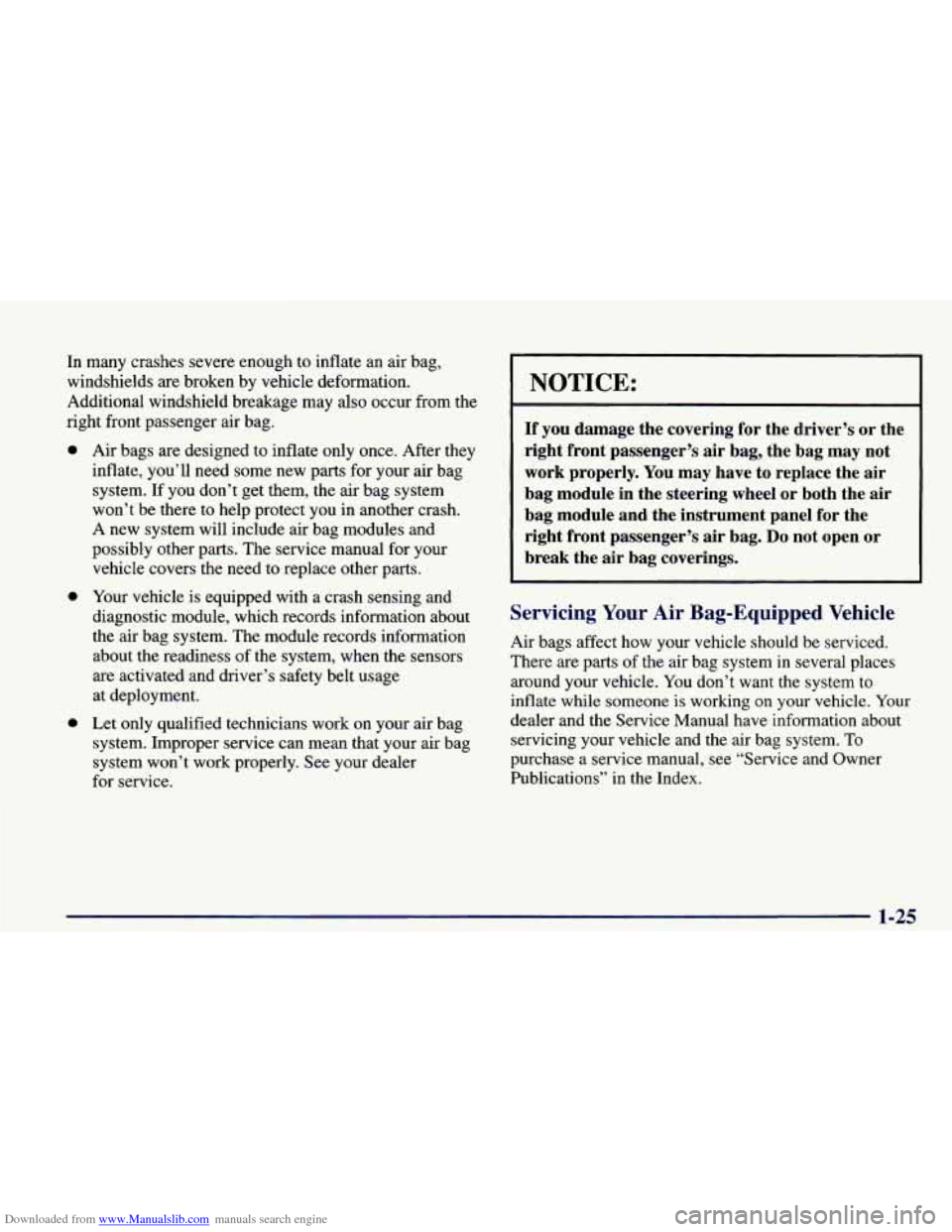
Downloaded from www.Manualslib.com manuals search engine In many crashes severe enough to inflate an air bag,
windshields are broken by vehicle deformation.
Additional windshield breakage may also occur from the
right front passenger air bag.
0
0 Air bags are designed to inflate only once. After they
inflate, you’ll need some
new parts for your air bag
system. If you don’t get them, the air bag system
won’t be there to help protect you in another crash.
A new system will include air bag modules and
possibly other parts. The service manual for your
vehicle covers the need to replace other parts.
Your vehicle is equipped with a crash sensing and
diagnostic module, which records infomation about
the air bag system. The module records information
about the readiness of the system, when the sensors
are activated and driver’s safety belt usage
at deployment.
Let only qualified technicians work on your air bag
system. Improper service can mean that your air bag
system won’t work properly. See your dealer
for service.
NOTICE:
If you damage the covering for the driver’s or the
right front passenger’s air bag, the bag may not
work properly. You may have to replace the air
bag module in the steering wheel or both the air
bag module and the instrument panel for the
right front passenger’s air bag.
Do not open or
break the air bag coverings.
Servicing Your Air Bag-Equipped Vehicle
Air bags affect how your vehicle should be serviced.
There are parts of the air bag system in several places
around your vehicle. You don’t want the system to
inflate while someone is working
on your vehicle. Your
dealer and the Service Manual have information about
servicing your vehicle and the air bag system.
To
purchase a service manual, see “Service and Owner
Publications”
in the Index.
1-25
Page 83 of 402
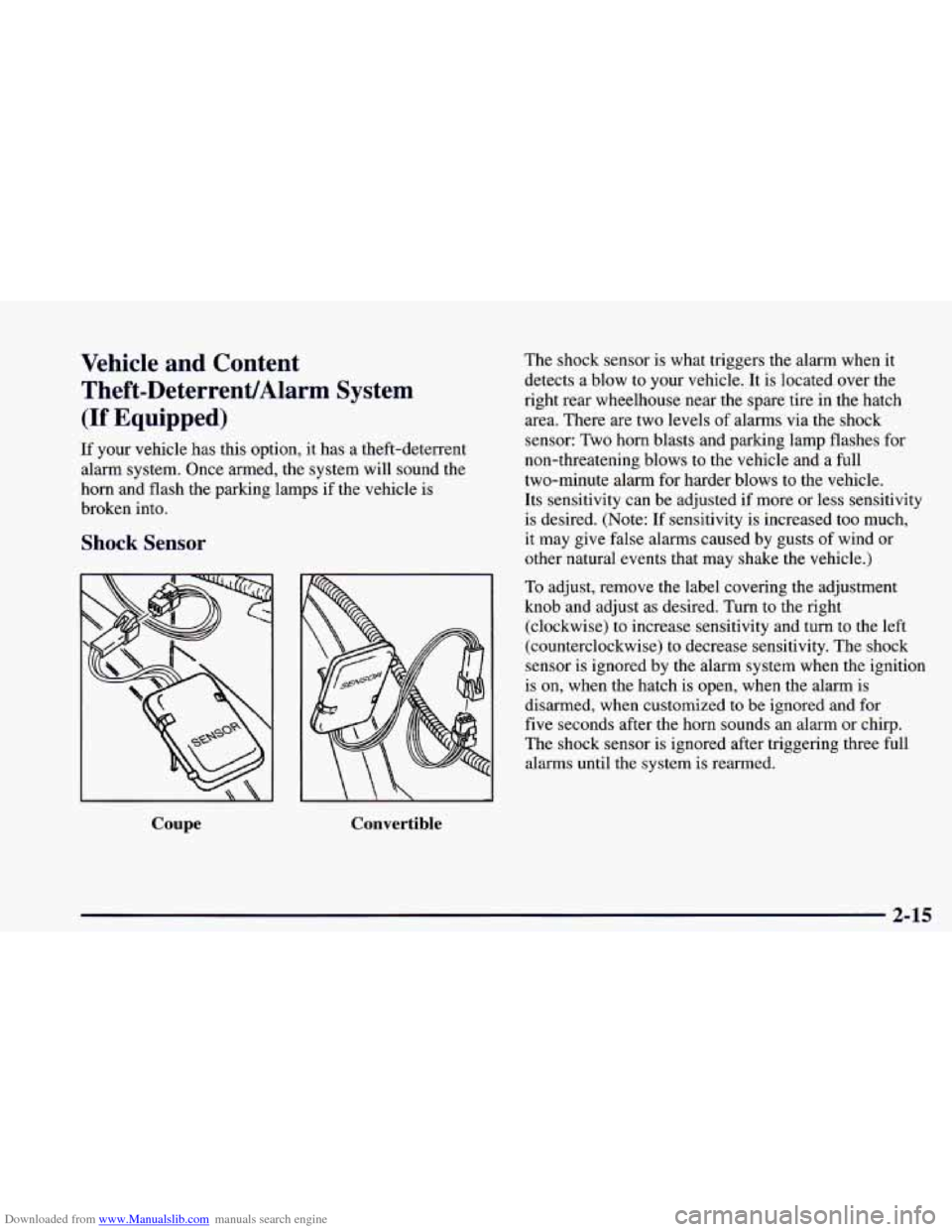
Downloaded from www.Manualslib.com manuals search engine Vehicle and Content Theft-DeterrenUAlarm System
(If Equipped)
If your vehicle has this option, it has a theft-deterrent
alarm system. Once armed, the system will sound the
horn and flash the parking lamps if the vehicle is
broken into.
Shock Sensor
Coupe Convertible
The shock sensor is what triggers the alarm when it
detects a blow
to your vehicle. It is located over the
right rear wheelhouse near the spare tire in the hatch
area. There are two levels
of alarms via the shock
sensor: Two horn blasts and parking lamp flashes for
non-threatening blows to the vehicle and
a full
two-minute alarm for harder blows to the vehicle.
Its sensitivity can be adjusted if more or less sensitivity
is desired. (Note:
If sensitivity is increased too much,
it may give false alarms caused by gusts
of wind or
other natural events that may shake the vehicle.)
To adjust, remove the label covering the adjustment
knob and adjust
as desired. Turn to the right
(clockwise) to increase sensitivity and turn to the left
(counterclockwise) to decrease sensitivity. The shock
sensor is ignored by
the alarm system when the ignition
is on, when the hatch is open, when the alarm is
disarmed, when customized
to be ignored and for
five seconds after the horn sounds an alarm or chirp.
The shock sensor is ignored after triggering three full
alarms until the system is rearmed.
2-15
Page 84 of 402
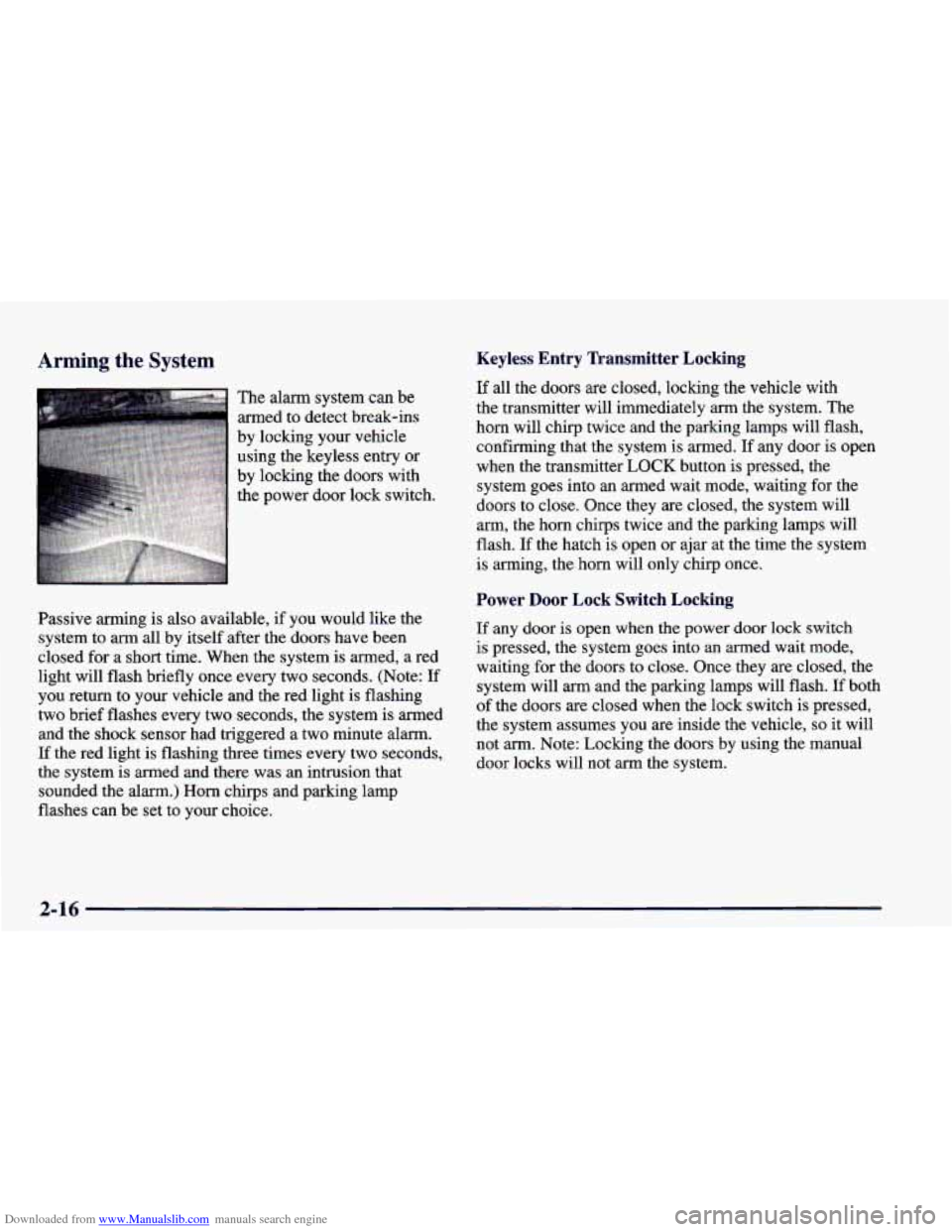
Downloaded from www.Manualslib.com manuals search engine Arming the System
The alarm system can be
armed to detect break-ins
by locking your vehicle
using the keyless entry or
by locking the doors with
the power door lock switch.
Keyless Entry Transmitter Locking
If all the doors are closed, locking the vehicle with
the transmitter will immediately arm the system. The
horn will chirp twice and the parking lamps will flash,
confirming that the system is armed.
If any door is open
when the transmitter
LOCK button is pressed, the
system goes into an armed wait mode, waiting for the
doors to close. Once they are closed, the system will
arm, the horn chirps twice and the parking lamps will
flash. If the hatch
is open or ajar at the time the system
is arming,
the horn will only chirp once.
Passive arming is also available, if you would like the
system to
arm all by itself after the doors have been
closed for a short time. When the system
is armed, a red
light will flash briefly once every two seconds. (Note: If
you return to your vehicle and the red light
is flashing
two brief flashes every two seconds, the system is armed
and the shock sensor had triggered a two minute alarm.
If the red light is flashing three times every two seconds,
the system
is armed and there was an intrusion that
sounded the alarm.) Horn chirps and parking lamp
flashes can be set to your choice.
Power Door Lock Switch Locking
If any door is open when the power door lock switch
is pressed,
the system goes into an armed wait mode,
waiting for the doors to close. Once they are closed, the
system will arm and the parking lamps will flash. If both
of the doors are closed when the lock switch is pressed,
the system assumes you are inside the vehicle,
so it will
not arm. Note: Locking the doors
by using the manual
door locks will not
arm the system.
2-16
Page 85 of 402
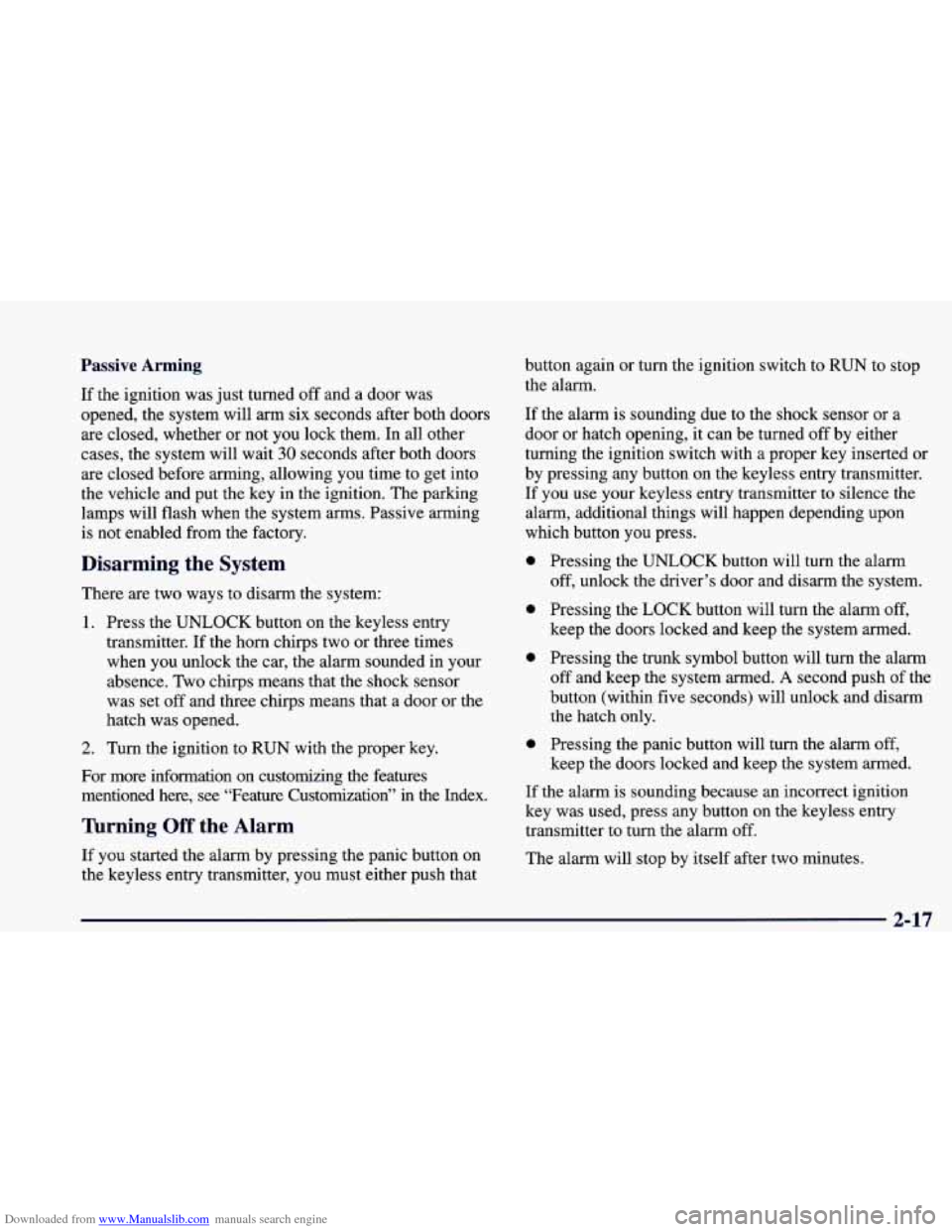
Downloaded from www.Manualslib.com manuals search engine Passive Arming
If the ignition was just turned off and a door was
opened, the system will arm six seconds after both doors are closed, whether or not you lock them. In all other
cases, the system will wait
30 seconds after both doors
are closed before arming, allowing you time to get into
the vehicle and put the key in the ignition. The parking
lamps will flash when the system arms. Passive arming
is not enabled from the factory.
Disarming the System
There are two ways to disarm the system:
1. Press the UNLOCK button on the keyless entry
transmitter. If the horn chirps two or three times
when you unlock the car, the alarm sounded in your
absence. Two chirps means that the shock sensor
was set off and three chirps means that a door or the
hatch was opened.
2. Turn the ignition to RUN with the proper key.
For more information on customizing the features
mentioned here, see “Feature Customization” in
the Index.
’Ibrning Off the Alarm
If you started the alarm by pressing the panic button on
the keyless entry transmitter, you must either push that button again
or turn the ignition switch to
RUN to stop
the alarm.
If the alarm is sounding due to the shock sensor
or a
door or hatch opening, it can be turned off by either
turning the ignition switch with
a proper key inserted or
by pressing any button on the keyless entry transmitter.
If you use your keyless entry transmitter to silence the
alarm, additional things will happen depending upon
which button you press.
0
0
0
0
Pressing the UNLOCK button will turn the alarm off, unlock the driver’s door and disarm the system.
Pressing the LOCK button will turn the alarm off,
keep the doors locked and keep the system armed. Pressing the trunk symbol button will turn the alarm
off and keep the system armed.
A second push of the
button (within five seconds) will unlock and disarm
the hatch only.
Pressing the panic button will turn the alarm off,
keep the doors locked and keep the system armed.
If the alarm is sounding because an incorrect ignition
key was used, press any button on the keyless entry
transmitter to turn the alarm off.
The alarm will stop by itself after two minutes.
2-17
Page 87 of 402

Downloaded from www.Manualslib.com manuals search engine If you’re ever driving and the SECURITY light comes
on and stays
on, you will be able to restart your engine
if you turn it off. Your PASS-Key I1 system, however,
is not working properly and must be serviced by
your dealer. Your vehicle is not protected by the
PASS-Key I1 system.
If you lose or damage a PASS-Key I1 ignition key, see
your dealer or a locksmith who can service PASS-Key I1
to have a new key made. In an emergency, call the
Chevrolet Roadside Assistance Center at 1 -800-CHEV-USA
(1 -800-243-8872).
Feature Customization (If Equipped)
Your vehicle’s locks and lighting systems can be
programmed with several different features. The
features you can program depend upon the options that
came with your vehicle. The following list tells you the
features that can be programmed. Listed next to each
feature is the option you need to have on your vehicle in
order to be able to program that particular feature.
0 Exit Lighting (available for all)
0 Delayed Illumination (available for all)
Last Door Closed Locking (if equipped with power
door locks)
Lockout Prevention (if equipped with power
door locks)
Keyless Entry Verification (if equipped with Vehicle
and Content Theft-DeterrendAlarm System)
Theft-Deterrent Arming Method (if equipped with
Vehicle and Content Theft-DeterrenUAlarm System)
Theft-Deterrent Arming Verification (if equipped with
Vehicle and Content Theft-Deterrent/Alarm System)
Driver’s Door Alarm Delay (if equipped with
Shock Sensor Enable (if equipped with Vehicle and
Vehicle and Content Theft-DeterrenUAlann
System)
Content Theft-DeterrendAlarm System)
2-19
Page 88 of 402
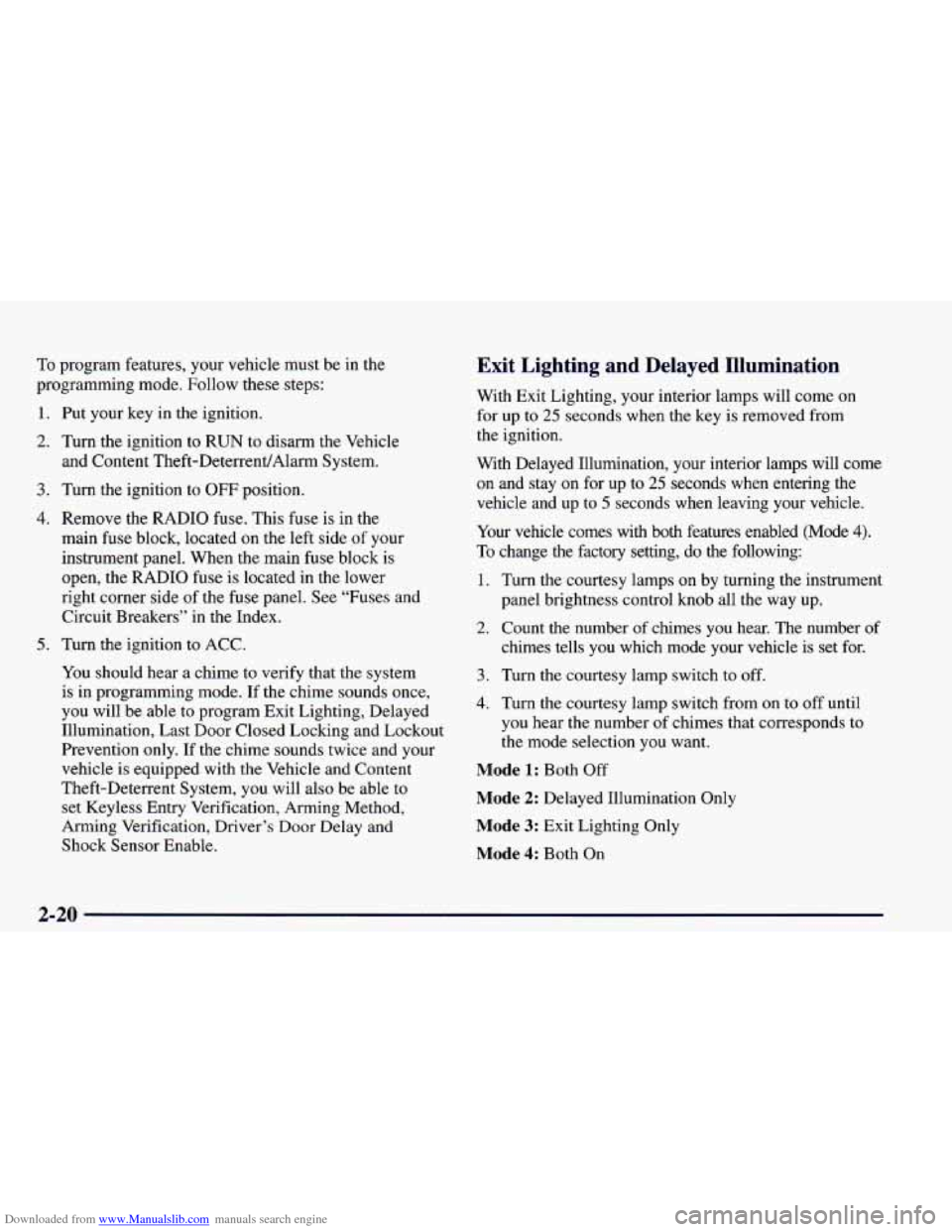
Downloaded from www.Manualslib.com manuals search engine ‘To program features, your vehicle must be in the
programming mode. Follow these steps:
1.
2.
3.
4.
5.
Put your key in the ignition.
Turn the ignition to RUN to disarm the Vehicle
and Content Theft-DeterrentIAlarm System.
Turn
the ignition to OFF position.
Remove the RADIO
fuse. This fuse is in the
main fuse block, located on the left side
of your
instrument panel. When the main fuse block is
open, the RADIO fuse
is located in the lower
right corner side
of the fuse panel. See “Fuses and
Circuit Breakers” in the Index.
Turn the ignition to ACC.
You should hear a chime
to verify that the system
is in programming mode.
If the chime sounds once,
you will be able to program Exit Lighting, Delayed
Illumination, Last Door Closed Locking and Lockout
Prevention only. If the chime sounds twice and your
vehicle is equipped with the Vehicle and Content
Theft-Deterrent System, you will also be able to
set Keyless Entry Verification, Arming Method,
Arming Verification, Driver’s Door Delay and
Shock Sensor Enable.
Exit Lighting and Delayed Illumination
With Exit Lighting, your interior lamps will come on
for up to
25 seconds when the key is removed from
the ignition.
With Delayed Illumination, your interior lamps will come
on and stay
on for up to 25 seconds when entering the
vehicle and up
to 5 seconds when leaving your vehicle.
Your vehicle comes with both features enabled (Mode
4).
To change the factory setting, do the following:
1. Turn the courtesy lamps on by turning the instrument
panel brightness control knob all the way up.
2. Count the number of chimes you hear. The number of
chimes tells you which mode your vehicle is set for.
3. Turn the courtesy lamp switch to off.
4. Turn the courtesy lamp switch from on to off until
you hear the number
of chimes that corresponds to
the mode selection you want.
Mode 1: Both Off
Mode 2: Delayed Illumination Only
Mode 3: Exit Lighting Only
Mode 4: Both On
2-20
Page 91 of 402
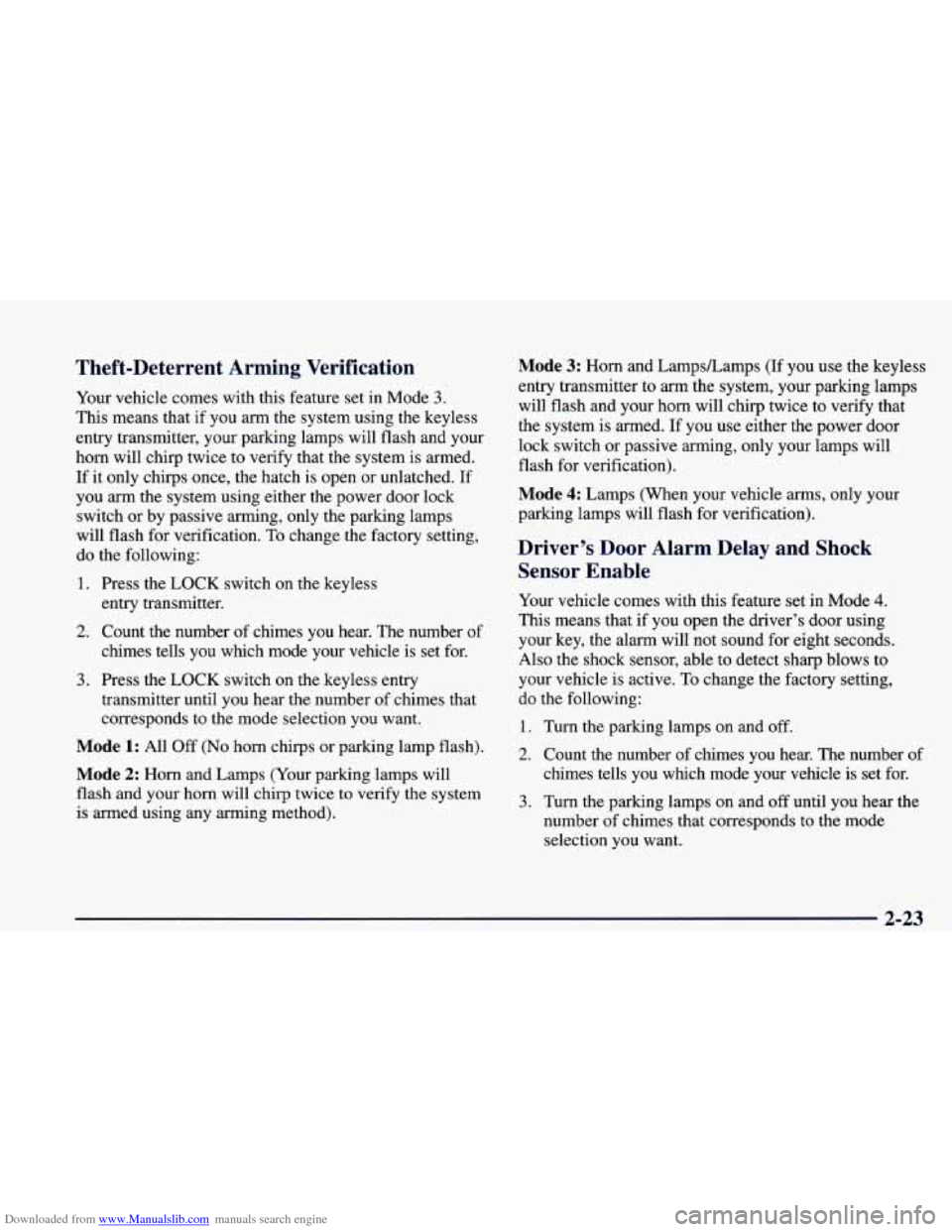
Downloaded from www.Manualslib.com manuals search engine Theft-Deterrent Arming Verification
Your vehicle comes with this feature set in Mode 3.
This means that if you arm the system using the keyless
entry transmitter, your parking lamps will flash and your
horn will chirp twice to verify that the system is armed.
If it only chirps once, the hatch is open or unlatched.
If
you arm the system using either the power door lock
switch or by passive arming, only the parking lamps
will flash for verification.
To change the factory setting,
do the following:
1. Press the LOCK switch on the keyless
entry transmitter.
2. Count the number of chimes you hear. The number of
chimes tells you which mode your vehicle is set for.
3. Press the LOCK switch on the keyless entry
transmitter until you hear the number of chimes that
corresponds to the mode selection you want.
Mode 1: All Off (No horn chirps or parking lamp flash).
Mode 2: Horn and Lamps (Your parking lamps will
flash and your horn will chirp twice to verify the system
is armed using any arming method).
Mode 3: Horn and LampsLamps (If you use the keyless
entry transmitter to
arm the system, your parking lamps
will flash and your horn will chirp twice to verify that
the system
is armed. If you use either the power door
lock switch or passive arming, only your lamps will
flash for verification).
Mode 4: Lamps (When your vehicle arms, only your
parking lamps will flash for verification).
Driver’s Door Alarm Delay and Shock
Sensor Enable
Your vehicle comes with this feature set in Mode 4.
This means that if you open the driver’s door using
your key, the alarm will not sound for eight seconds.
Also the shock sensor, able to detect sharp blows to
your vehicle
is active. To change the factory setting,
do the following:
1. Turn the parking lamps on and off.
2. Count the number
of chimes you hear. The number of
chimes tells you which mode your vehicle is set for.
3. Turn the parking lamps on and off until you hear the
number of chimes that corresponds to the mode
selection you want.
2-23
Page 92 of 402
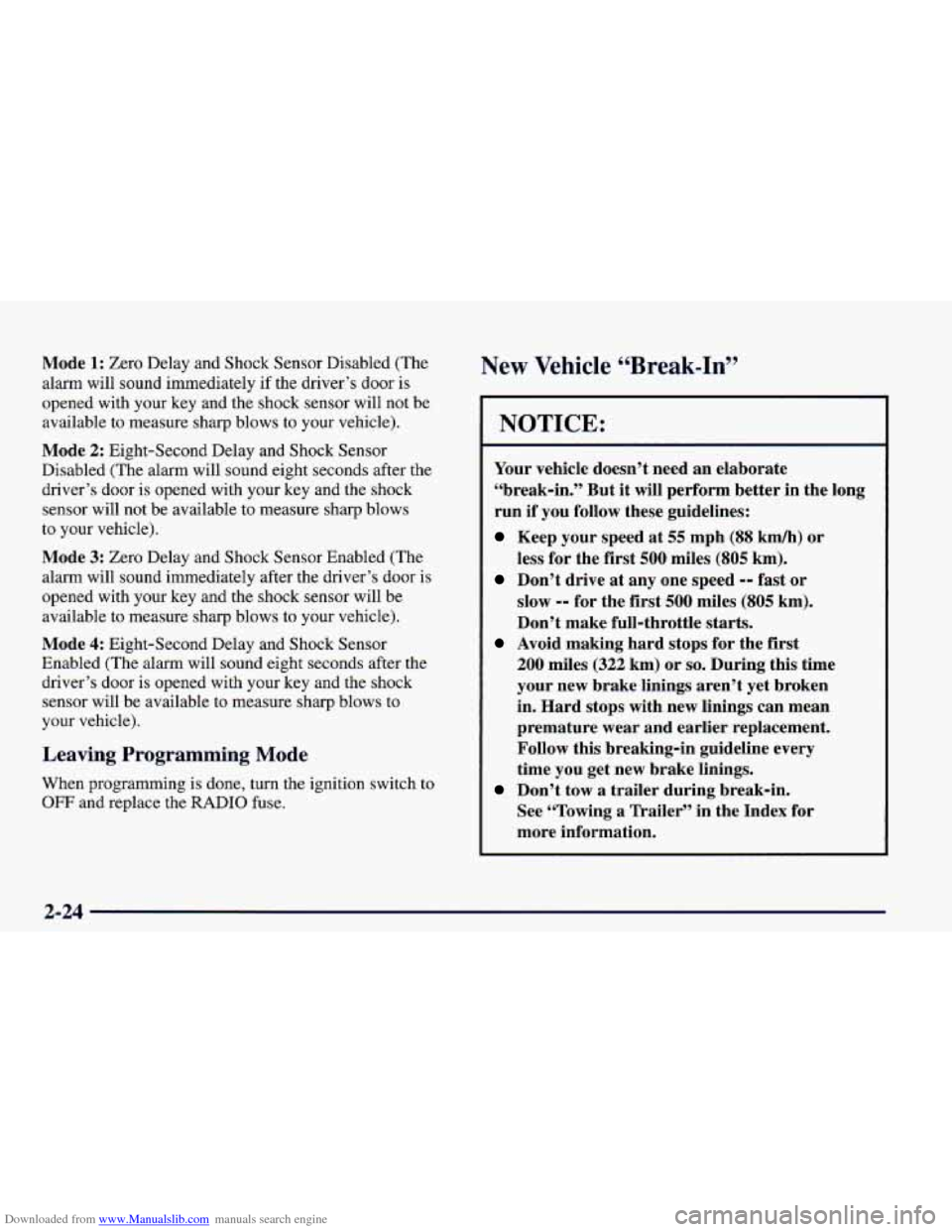
Downloaded from www.Manualslib.com manuals search engine Mode 1: Zero Delay and Shock Sensor Disabled (The
alarm will sound immediately if the driver’s
door is
opened with your key and the shock sensor will not be
available to measure sharp blows
to your vehicle).
Mode
2: Eight-Second Delay and Shock Sensor
Disabled (The alarm will sound eight seconds after the
driver’s door
is opened with your key and the shock
sensor will not be available to measure
sharp blows
to your vehicle).
Mode
3: Zero Delay and Shock Sensor Enabled (The
alarm will sound immediately after the driver’s door is
opened with your key and the shock sensor will be available to measure
sharp blows to your vehicle).
Mode
4: Eight-Second Delay and Shock Sensor
Enabled (The alarm will sound eight seconds after the
driver’s door is opened with your key and the shock
sensor will be available
to measure sharp blows to
your vehicle).
Leaving Programming Mode
When programming is done, turn the ignition switch to
OFF and replace the RADIO fuse.
New Vehicle “Break-In”
NOTICE:
Your vehicle doesn’t need an elaborate
“break-in.” But it will perform better in the long
run if
you follow these guidelines:
Keep your speed at 55 mph (88 kmh) or
less for the first
500 miles (805 km).
Don’t drive at any one speed -- fast or
slow -- for the first 500 miles (805 km).
Don’t make full-throttle starts.
200 miles (322 km) or so. During this time
your new brake linings aren’t yet broken
in. Hard stops with new linings can mean
premature wear and earlier replacement.
Follow this breaking-in guideline every
time
you get new brake linings.
See “Towing
a Trailer” in the Index for
more information.
Avoid making hard stops for the first
Don’t tow a trailer during break-in.
2-24
Page 119 of 402
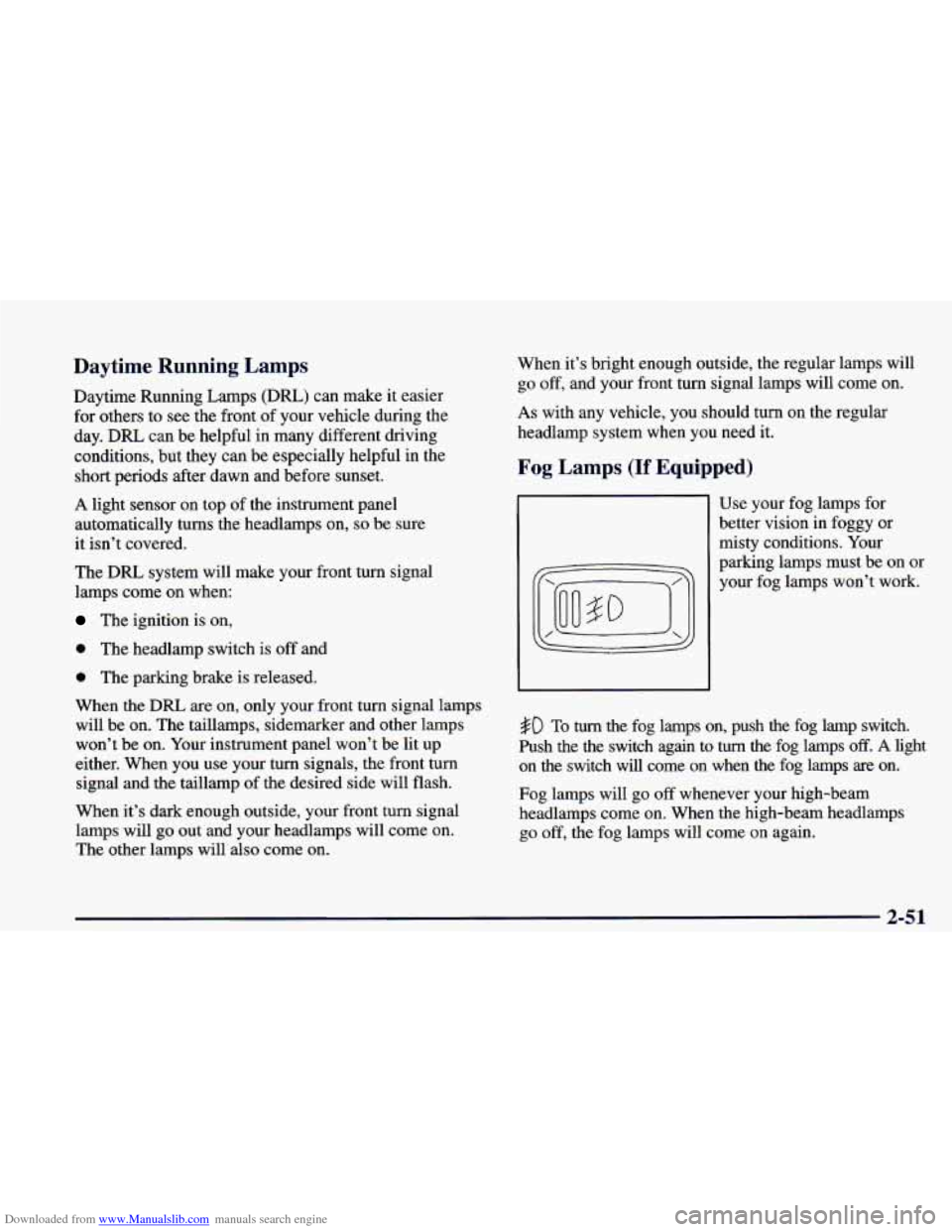
Downloaded from www.Manualslib.com manuals search engine Daytime Running Lamps
Daytime Running Lamps (DRL) can make it easier
for others to see the front of your vehicle during the
day. DRL can be helpful
in many different driving
conditions, but they can be especially helpful in the
short periods after dawn and before sunset.
A light sensor on top of the instrument panel
automatically turns the headlamps
on, so be sure
it isn’t covered.
The
DRL system will make your front turn signal
lamps come on when:
The ignition is on,
0 The headlamp switch is off and
0 The parking brake is released.
When
the DRL are on, only your front turn signal lamps
will be on. The taillamps, sidemarker and other lamps
won’t be on. Your instrument panel won’t be lit up
either. When you
use your turn signals, the front turn
signal and the taillamp of the desired side will flash.
When it’s dark enough outside, your front turn signal
lamps will go out and your headlamps will come on.
The other lamps will also come on. When it’s
bright enough outside, the regular lamps will
go
off, and your front turn signal lamps will come on.
As with any vehicle, you should turn on the regular
headlamp system
when you need it.
Fog Lamps (If Equipped)
Use your fog lamps for
better vision in foggy or
misty conditions. Your
parking lamps must be on or
your fog lamps won’t work.
#D To turn the fog lamps on, push the fog lamp switch.
Push the the switch again to
turn the fog lamps off. A light
on the switch will come on when the fog lamps are on.
Fog lamps will go
off whenever your high-beam
headlamps come on. When the high-beam headlamps
go off, the fog lamps will come on again.
2-51
Page 144 of 402

Downloaded from www.Manualslib.com manuals search engine Gages can indicate when there may be or is a problem
with one of your vehicle’s functions. Often gages and
warning lights work together to let you know when
there’s a problem with your vehicle.
When one
of the warning lights comes on and stays
on when you are driving, or when one of the gages
shows there may be
a problem, check the section that
tells you what to do about it. Please follow this manual’s
advice. Waiting to do repairs can be costly
-- and even
dangerous.
So please get to know your warning lights
and gages. They’re a big help.
Safety Belt Reminder Light
When the key is turned to RUN or START, a chime
will come
on for about eight seconds to remind people
to fasten their safety belts.
The safety belt light will
also come on and stay on
for about
70 seconds. If
the driver’s belt is already
buckled, neither the chime
nor the light will come
on.
Air Bag Readiness Light
There is an air bag readiness light on the instrument
panel, which shows
AIR BAG. The system checks the
air bag’s electrical system for malfunctions. The light
tells you if there is an electrical problem. The system
check includes the air bag sensors, the air bag modules,
the wiring and the crash sensing and diagnostic module.
For more information on the air bag system, see “Air
Bag” in the Index.
AIR
BAG
This light will come on
when
you start your engine,
and it will flash for
a few
seconds. Then the light
should go out. This means
the system is ready.
If the air bag readiness light stays on after you start the
engine or comes on when you are driving, your air bag
system may not work properly. Have your vehicle
serviced right away.
The air bag readiness light should flash for
a few
seconds when you
turn the ignition key to RUN. If the
light doesn’t come on then, have it fixed
so it will be
ready to warn you
if there is a problem.
2-76